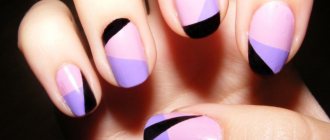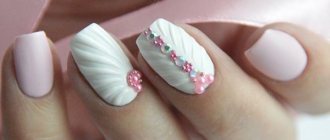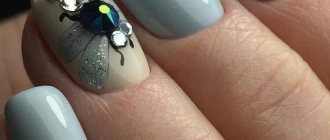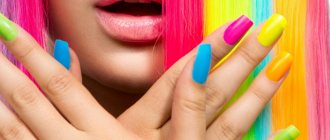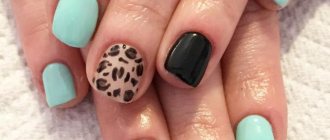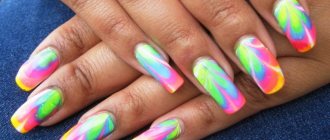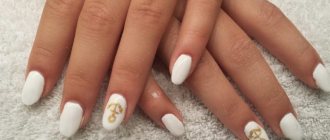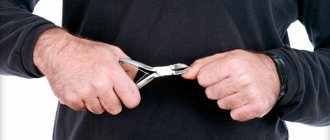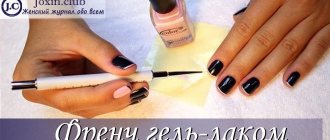It's easy to do a water manicure at home, but you need some inspiration and skill. The main feature of this design is that you will never repeat the unique design that once fell on your nails by chance. This interesting technique gives unlimited freedom to experiment with color and pattern.
To create a design you will need:
- multi-colored varnishes
- orange stick
- rich cream, Dadi'Oil cuticle oil or liquid tape
- base and top for varnish
- a container of warm water and the desire to create something similar to the midday dream of an impressionist artist
What is water manicure
Designers in the nail industry have come up with a new trend for lovers of interesting and unique designs on their nails - water manicure. It is also called marbling or aqua manicure.
Water manicure got its name due to the technique of performing it, during which an ornate pattern is created on the surface of the water with the help of colored varnishes and a toothpick. The resulting ornament is transferred to the surface of the marigolds in several ways.
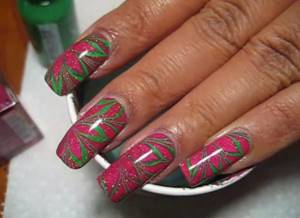
The drawings created thanks to this technique look very original and intricate, and a wide variety of varnish shades can be used. Aqua manicure is one of the most creative and unique, but learning the art of doing aqua manicure at home is not at all difficult, you just need a little practice and time. Let's take a closer look at what tools and materials are needed to independently create intricate designs on your nails.
There are three most common ways to create a water manicure:
- Standard water manicure , when the nail plate is dipped in a container of water to apply a design to it;
- Dry manicure , when a varnish pattern is formed on the surface of the water and transferred to the nails only after complete drying;
- Marble water manicure , in the process of which hairspray is used. Let's look at how exactly this happens next.
Reviews
According to reviews from girls who did water manicure with gel polish at home, it is quite difficult, but you should not give up. The main mistake was incorrectly selected varnishes and too hot or cold water. As previously mentioned, all this affects the process of formation of the varnish film.
According to reviews from women who had a manicure using this technology in a salon, the result exceeds all expectations. The process is interesting and fascinating, as each time an interesting and unique mixing of varnish colors occurs. Manicure looks good even on short nails. The only drawback is the duration of the procedure.
Water manicure is beautiful and fashionable, but the process takes time. Follow all the rules, and the result will not take long to arrive. If you don’t succeed the first time, try again, and everything will definitely work out. Let your nails always have a beautiful manicure!
Source
Required tools and materials
The list of necessary equipment for water design is not very long:
- Small bowl with water .
Considering the materials you need to work with and the technology, it is better to take disposable dishes. A plastic cup is quite suitable for these purposes. The water must be clean, always at room temperature. In hot water, the varnishes will become liquid and spread too much, and cold water will cause the varnishes to harden more quickly, which will also negatively affect the final result. - Scotch tape, adhesive tape, special liquid tape , such as Naomi, Fire Star, Masura, Skin Defender, or any adhesive paper to protect the skin around the nails from polish;
- A product for the cuticle area that will protect against color composition. Oil, cream, PVA glue will do;
- Dots , needle, toothpick, or skewer for creating a pattern on the water surface;
- Use a toothpick or cotton swab to remove excess color film in the water around your finger;
- Nail polish remover;
- Cotton sponges;
- Base and top coat;
- Colored varnishes, at least two different shades . You can use more pigmented compounds to create a pattern that is more iridescent and contrasting.
Water manicure at home
It's no secret that half the success of a manicure depends on the quality of the material. What should you arm yourself with if you want to design your nails in this way yourself?
- Container with water - it is recommended to use disposable containers or cut off the top of a plastic bottle. It’s easy to work with disposable tableware, because after the procedure you can simply throw it away
- There is, of course, a danger that the plastic cup will tip over, but this can be easily avoided if you put a few coins on the bottom or prop it up on the sides with something. The water poured there must be at room temperature. Some people advise dissolving the varnish in ice water, but you are unlikely to achieve anything with this
IMPORTANT: Don’t even touch the bowls and cups, otherwise you’ll think for a long time about how to wipe off any remaining varnish from your favorite dishes.
We stock up on everything we need
- Nail polish is the main component of a manicure. It’s worth saying right away that in this case not just any varnish is suitable. Unfortunately, many girls have to go through more than one type of varnish before finding the right one. But then, believe me, the result will be worth it. In your search, start from the fact that the varnish must certainly have a liquid consistency
- Over time, the varnish in a bottle tends to become more viscous, so it is preferable to use only purchased material. Keep in mind that the structure of the varnish may change if you dilute it with acetone, so this trick is not suitable
- Another secret is good pigmentation. In other words, if one layer covers the natural pigment of the nail, the polish is good. Stop choosing one brand so as not to suffer due to texture mismatch

Thick texture varnish
- It is very important to take care of something that will protect not only the cuticle, but also the fingers. Please note that a water manicure is not a regular application of varnish and is not a gradient, after which there is not much excess left.
- Be prepared for the fact that in this case, about half of your finger may become dirty. Of course, manual cleaning will be quite troublesome, so it’s better to prevent this trouble. This can be done using paper masking tape or a thick cream, preferably for children.
- If you have manicure wax, use it, it also helps a lot. If the choice fell on tape, stock up on scissors
Cream
- Cotton pads and nail polish remover - even if you protect the areas near your nails, there may still be excess left, so place a bottle of special liquid nearby and put some cotton wool

Nail polish remover
- Toothpicks or a needle are also a necessary tool; you will use them to draw varnish patterns on the water surface
IMPORTANT: It all depends on what you are ready to make a choice in favor of - accuracy or saving time. If in favor of the first, then it is better to take a needle, but it will take a long time to wash it after each nail treatment, so to save time it is recommended to choose several toothpicks.

A set of toothpicks must be present
- Base, top and drying agent are all equally important. The base can be either transparent or colored, depending on your personal preferences.
- The top will give the entire manicure a complete look. As for drying, everything is clear here - it is indispensable for saving time, because water manicure itself is already a rather lengthy process
drying and top
Selection of varnishes
Let's talk about what coatings are best to use to create a water pattern. There are several simple recommendations, following which you can get a high-quality and beautiful drawing at home.
- Firstly, choose fresh compositions that have not yet begun to thicken. If they already have a viscous structure, they will not be able to spread freely over the water surface;
- Secondly, avoid quick-drying ones, which will harden almost immediately in the water, and you won’t have time to create the necessary ornament and transfer it to your nails;
- And, of course, choose high-quality materials, preferably from the same brand. In this case, they will have the same texture and drying speed, which will make the pattern better and more expressive;
- Do not use coatings that contain glitter, because under their own weight they will most likely settle to the bottom of the container. If you want to add shine, opt for a coating with a pearl sheen;
- For a water pattern you need to use regular varnishes; gel varnishes are not suitable due to their denser structure. The drawing itself can be transferred either to a gel base or to a regular one.
A small list of varnish manufacturers with whom we have never had problems creating patterns on water:
- Golden Rose
- Revlon;
- O.P.I.
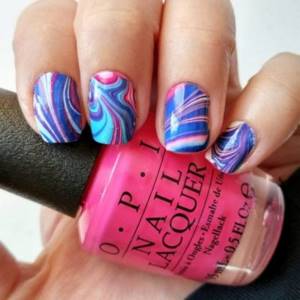
- Farmasi;
- China Glaze
How to choose the right gel polish: we analyze all its types and top brands
Design of aquarium nail art with glitter
Decorative material such as glitter has many types and is successfully used in many techniques. That is why designers confidently introduced such decor into three-dimensional aqua manicure pictures. Sequins have different shapes, sizes and colors, so it’s a pleasure to work with them and create your own fantasy composition. Do you want a sparkling jacket? Simply apply glitter particles to the tip of your nail plate in the shape of a smile. Do you want to create something similar to a gradient on your nails? Glitter will do the job perfectly. Did the intended design begin to seem too simple during design? A few shiny fragments and marigolds look more fresh and interesting. All in your hands!
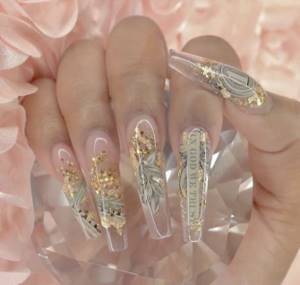
As you can see, any decorative additions can be used in aquarium nail design, and the technique itself, although it takes a lot of time to complete, is not at all different from other examples in anything supernatural. Especially if you entrusted the beauty of your hands to an experienced and skilled craftsman.
Advantages and disadvantages
The advantages of this unusual nail art:
- Huge selection of patterns and shade combinations. There are no restrictions on the number of varnishes used, with the help of which it is possible to make a wide variety of ornaments on water;
- Water manicure looks beautiful on nails of any length and shape;
- The manicure can be complemented with a design such as rhinestones, sparkles, and negative space. It will always look original and attractive;
- A simple technique that can be easily used at home.

Negative points:
- The need to use protective agents for the periungual areas of the skin;
- In the process of creating ornaments, there is a large consumption of pigmented varnishes. Get ready for the fact that after one procedure the bottle may be a third empty. When using this technique, a couple of drops of material is not enough;
- You need to spend a lot of time decorating your nails using this technique, especially if you want to cover all your nails with water patterns.
Stylish water design ideas
Now you know how to make stylish water nail art step by step. Agree, there is nothing supernatural in this. Everything can be quite easy if you understand the technique and have some practice. Flowers, waves, zigzags, tiger color - these are just some of the things you can do with a wave of a toothpick, like an artist's brush. We invite you to look at an excellent collection of photos that present interesting ideas for water nail art.
When doing a manicure, you don’t have to limit yourself to just varnishes. While the pattern dries, decorate your nails with rhinestones. Accentuate your sexy curves with a sprinkle of glitter. You can even make an unusual French manicure by dipping only the free edge of the nail into water. The smile line will be decorated with sparkling varnish. Take a look at the dizzying compositions presented in the photo.
Knowing how to do water manicure at home, you can create stunning decorations. You don't have to use only bright colors. Try creating, for example, a black and white design by watching an interesting video tutorial.
Preparation
Before performing an aqua manicure, you need to make preparations so as not to be distracted during the process.
- Lay out all the necessary tools and materials, pour ordinary water at room temperature into the container.
- Also prepare your nails: remove the old coating, if any, treat the cuticles, give the nails the desired shape and apply a base coat. Painting your nails with white polish will make even a thin layer of color look brighter and richer.
- The next stage of preparation will be to apply cream or oil to the periungual areas of the skin to protect them from varnish. The product must be applied carefully so as not to touch the nail plate, otherwise the pattern will not be fixed on it. If you are afraid that the greasy product will get into the water and interfere with your manicure, then you can carry out this procedure after finishing decorating the nail plates and removing excess thin film in order to moisturize the cuticle and skin after removing the remaining colored film.
- The last thing to do is to stick tape or adhesive tape on your finger, above the nail and up to the second phalanx. This will also protect the skin from unwanted staining. We recommend immediately sealing all the fingers on which you are planning to apply an aqua manicure, so as not to waste time in the process and not spoil the nails already done.
What if it doesn't work out?
The most common mistakes involve mistakes such as choosing a narrow container for water. It is advisable to choose wider and deeper so that your fingers do not touch the edges and your nails do not reach the bottom.
Dirty toothpick. As already written above, it must be wiped after each wetting.
The varnish should not be too viscous; if necessary, it can be diluted with water. Be sure to remove excess polish from the water while your fingers are in it. Otherwise, excess varnish can ruin the entire drawing and make it blurry.
Step-by-step instructions for various techniques
Let's look at common and convenient ways to create an aqua manicure.
Dipping your nails in water
The simplest and most accessible is considered to be a water manicure with immersing nails in a container. It is done in the following sequence:
- Take the first pigmented varnish and drop it into the center of a container of water. The drop will immediately begin to spread over the surface.
- Drop a mixture of a different shade into the center of the resulting color circle.

- Then you can use the first shade or use another color. You can take any number of colors; the richer the palette, the more interesting the ornament. It is necessary to again make a drop in the center of the circle formed by the two previous compositions.
- As a rule, for a complex and graphic design, 10-20 circles are made on the surface of the water. They need to be done quickly so that the varnishes do not have time to dry out.

- Using a toothpick, needle or dots, draw lines on the resulting circles in any direction: across, along, from the center to the edge, diagonally. As a result, interesting patterns are formed. The end of a sharp tool does not need to be deeply immersed in water and it is recommended to wipe it after each line drawn so that the colored layers do not stick and thereby spoil the pattern.
- To transfer the design to the nail, dip your finger, nail side down, parallel to the water surface, into the center of the container. Hold motionless for 10-15 seconds so that the pattern does not smudge and is fixed on the nail. You can dip two fingers into the colored film at once.
- Collect the remaining colored film around your finger in the water with a toothpick or cotton swab.
- Remove the finger with the film attached to it from the water. Remove the protective tape and use a cotton swab soaked in nail polish remover to carefully remove excess polish film from the skin around the nail. Now it’s clear why you need to protect the skin around the nail. Otherwise, removing the color layer is problematic.
- Wait until the pattern dries. This will take a little longer than usual because varnishes with water take longer to dry. Apply a topcoat to protect your manicure from chipping and damage. Aqua manicure is ready!
The video shows the technique of creating patterns in more detail:
Water painting on nails can also be done using a gel base. All stages are performed in the same sequence. The only difference will be the need to dry the base layer, the main color if used for design, and the top coat in a lamp.
Without putting your finger in the water
This technique is also called dry manicure. This is due to the fact that the pattern is transferred to the nails in a frozen form. To do this you need:
- Perform the first five steps of the standard aqua manicure technique from the previous instructions.
- Leave the film on the surface of the water for about half an hour to dry completely.
- Carefully remove the resulting colored circle from the water and cut it into several pieces of the desired size.
- Colored pieces on your nails can be fixed with clear polish.
- When the design is dry, the excess film must be carefully removed with a nail file.
- Apply a layer of fixative varnish on top.
You can clearly see the dry manicure technique in the video:
Marble stains with hairspray
The aqua manicure technique is ideal for creating a marble pattern on your nails. It is also called foam stains.
To achieve this effect you must:
- Dissolve three to five drops of varnish of the same color on the surface of the liquid.
- Immediately, before they set and begin to harden, spray them once with hairspray or other hair spray.
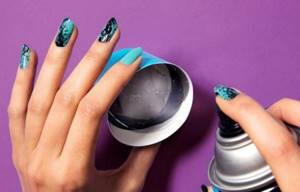
- This way, a completely unusual and unique pattern is obtained, visually reminiscent of foam.
- Then we lower our fingernail into the water parallel to its surface and do everything in the same way as with a regular aqua manicure.

You can take a closer look at the marigold marbling technique in the video:
Color combinations and patterns for aqua manicure
To begin with, it is better to perform a trial version of the manicure using black and white varnishes. This decor will be the easiest to work with; you can practice well on it.
In the future, up to 4 shades are used, which successfully combine with each other or harmonize with the tone of the clothing.
For example, to go with a bright beach suit, you can choose neon polishes in yellow, pink, orange, and green shades.
In general, a combination of bright and more neutral varnishes works well for water nail art, but you can show your creativity in different ways.
Colors that go well together
- Preparing the pattern for transfer to the nail
- Black and white
- Yellow, orange, red
- Red, white, gray
- Apricot, brown, turquoise
- White, emerald, lime
- Chocolate, white, beige
- White, grey, blue
Drawings can be varied. If you move a sharp stick along the varnish from the edges to the center, you will get a flower, from the center to the edges you will get a star.
You can even make chaotic movements to make the drawing original and unusual.
Products and tools for creating marble manicure
To create a beautiful aqua manicure you will need:
- Shallow but wide dishes
- Water (temperature 20-24 degrees)
- Nail polishes
- Cotton buds
- Cotton pads
- Oily hand cream
- Toothpicks
- Scotch
- Nail polish remover
- Fixer
Possible mistakes
When creating a decorative pattern, problems may arise, especially if you are using this technique for the first time. Let's look at which of them appear most often and how you can eliminate them:
- The drop is drowning . The reason may be an incorrectly chosen height of the brush from which the color composition falls. Do not raise it more than two centimeters above the surface;
- The drop does not spread . The varnishes chosen for the decoration are old and thick. Take only fresh, liquid formulations;
- Varnishes of different colors are unevenly distributed over the surface of the water . This may occur due to differences in texture and density of the compositions. Try to use polishes from the same brand;
- The patterns get confused and blurred . This happens due to a poorly cleaned toothpick. Wipe it after each time it is placed in the container;
- Colored spots do not form patterns well. This happens when the water selected is too warm or cold. We recommend using water with a temperature of no more than 40 degrees; the ideal solution would be water at room temperature.
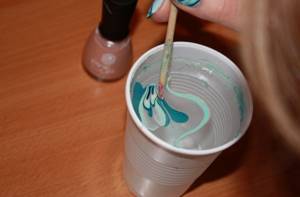
Useful tips and secrets for creating the perfect water manicure
Sometimes a water manicure turns out unsuccessful. To ensure everything goes smoothly, you need to follow these tips:
- Low or high temperature water and thick varnish are the reasons for the lack of the desired result
- The varnish sinks in water if it is dripped from too high a height, more than 1 cm
- If your manicure smudges, you should take your finger out of the water more slowly.
- In order for the drawing to be of high quality, you do not need to immerse most of the knitting needle in water - you only need to wet the tip
- After each manipulation, the skewer must be wiped on cotton wool so as not to spoil the design.
- It is better to take varnishes from one manufacturer for water manicure.
Aqua manicure looks very beautiful and catchy, but it is quite labor-intensive, and learning how to make really beautiful designs will not be possible the first time. If you have patience and high-quality varnishes, you can achieve excellent results!
More interesting articles:
